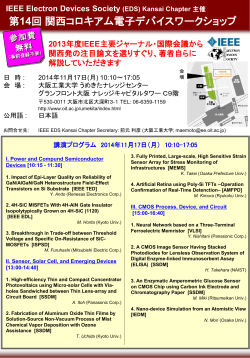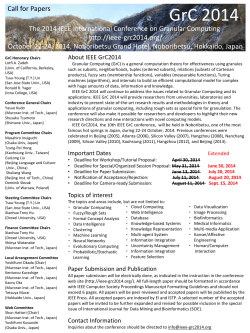
Issues on 256-FFT per 20MHz
Nov. 2014 doc.: IEEE 802.11-14/1228r2 Issues on 256-FFT per 20MHz Date: 2014-11-03 Authors: Name Affiliations Heejung Yu Yeungnam Univ. (NEWRACOM) Daewon Lee NEWRACOM 9008 Research Drive, Irvine, CA 92618 Minho.cheong@newracom.com Minho Cheong NEWRACOM 9008 Research Drive, Irvine, CA 92618 Daewon.lee@newracom.com Submission Address Phone email heejung@yu.ac.kr Slide 1 Heejung Yu, Yeungnam Univ./NEWRACOM Nov. 2014 doc.: IEEE 802.11-14/1228r2 Background (1) • For 11ax, throughput improvement and outdoor operation are required as in PAR. • In [1] and [2], 256-subcarrier in 20MHz BW was considered for longer CP and more number of available subcarriers. • To change the OFDM symbol structure, i.e., CP and subcarrier spacing, the performance and compatibility issues should be addressed. Submission Slide 2 Heejung Yu, Yeungnam Univ./NEWRACOM Nov. 2014 doc.: IEEE 802.11-14/1228r2 Background (2) • Check points in changing OFDM symbol structure – Mid-packet CCA in secondary channels – PAPR problem – Residual CFO (after estimation and compensation), SFO, phase noise tracking • In this contribution, issues which should be considered to change the OFDM symbol structure are addressed. Submission Slide 3 Heejung Yu, Yeungnam Univ./NEWRACOM Nov. 2014 doc.: IEEE 802.11-14/1228r2 Mid-packet CCA (1) • 11ac used mid-packet detection for secondary channel CCA – Intension: detect an OBSS OFDM(non-HT, HT, VHT) transmissions not occupying Primary 20MHz (CCA level is 72dBm which is10dB higher than preamble detect levels within aCCAMidTime(25us)) – Simplest method to detect mid-packet detection is CP correlation of OFDM symbols Submission Slide 4 Heejung Yu, Yeungnam Univ./NEWRACOM Nov. 2014 doc.: IEEE 802.11-14/1228r2 Mid-packet CCA (2) • We assume 11ax devices use the same time requirement as 11ac devices for mid-packet CCA detection. • This value is 25usec which is >6x OFDM symbol duration of 4usec. • Therefore, 11ac devices can use minimum of 5 consecutive symbols for normal CP and short CP cases. 4 usec (OFDM symbol duration) CP Submission 25usec Slide 5 time Heejung Yu, Yeungnam Univ./NEWRACOM Nov. 2014 doc.: IEEE 802.11-14/1228r2 Mid-packet CCA (3) • In the worst case the 25usec detection window may not fully cover even a single OFDM symbol duration. (See the below figures). CP CP 3.2usec 12.8usec 12.8usec OFDM symbol duration 0.8usec Submission 3.2usec CP CP 12.8usec OFDM symbol duration Detection Window 25usec Detection Window 25usec 0.8usec Slide 6 12.8usec time Heejung Yu, Yeungnam Univ./NEWRACOM Nov. 2014 doc.: IEEE 802.11-14/1228r2 Mid-packet CCA (4) • Three potential fixes also have problems of their own – longer aMidCCATime can be adopted. • longer aMidCCATime results in 11ax devices sensing secondary channels to have lower priority in the use of the secondary channels. – For mid-packet CCA, use other feature of an OFDM packet, e.g. pilot pattern. • The possible sensing level should be checked. • More restriction on the design of pilot. – Do not support a separate mid-packet CCA rules (for OFDM packet and for other any signal) in 11ax, i.e., perform only energy detection. • Fairness of usage of the secondary channels is compromised. Submission Slide 7 Heejung Yu, Yeungnam Univ./NEWRACOM Nov. 2014 doc.: IEEE 802.11-14/1228r2 Mid-packet CCA (5) • Examples where mid-packet CCA is issued. – OBSS with non-aligned primary channel • After receiving a packet from own BSS, detect the a packet from OBSS occupying secondary CH. Primary CH of OBSS Primary CH of own BSS Packet from BSS (11ax device) This data part should be detected. Packet from own BSS (11ac device) – The miss-detection of secondary channels by 11ac devices can cause very harmful effects to 11ax operation. Submission Slide 8 Heejung Yu, Yeungnam Univ./NEWRACOM Nov. 2014 doc.: IEEE 802.11-14/1228r2 Mid-packet CCA (6) • In this contribution, we assume that 11ac devices use a CP correlation method for mid-packet CCA. • However, other mid-packet CCA can be considered. – ED can be used, but ED cannot verify that the signal is a WiFi signal or not. – Pilot structure and other features of WiFi signals can be used. Submission Slide 9 Heejung Yu, Yeungnam Univ./NEWRACOM Nov. 2014 doc.: IEEE 802.11-14/1228r2 PAPR (1) • The coverage of BSS is governed by the range of a beacon frame with legacy format. • Packets with 256FFT in 20MHz have higher PAPR than 64FFT. • Higher backoff may be required. – Potentially a smaller coverage with a 20MHz-256FFT packet • High PAPR leads to lower PA efficiency. Submission Slide 10 Heejung Yu, Yeungnam Univ./NEWRACOM Nov. 2014 doc.: IEEE 802.11-14/1228r2 CDF of PAPR 1 0.9 0.8 • 20 OFDM symbol (only data part) (BPSK) • 8x oversampling • 20000 packets 0.7 0.5 0.4 0.3 0.2 64 FFT (56 tones) 256 FFT (242 tones) 0.1 0 2 4 6 8 10 PAPR (dB) 12 14 16 18 • At CDF of 99%, 256FFT packets show 1dB higher PAPR than 64FFT packet. 1 0.98 0.96 CDF CDF 0.6 0.94 0.92 0.9 64 FFT (56 tones) 256 FFT (242 tones) 9 Submission 10 11 12 13 PAPR (dB) 14 15 16 17 Slide 11 Heejung Yu, Yeungnam Univ./NEWRACOM Nov. 2014 doc.: IEEE 802.11-14/1228r2 CFO, SFO and phase noise (1) • In [1] and [2], CFO estimation and compensation is considered for performance evaluation. However, tracking with pilots is not included. • As the subcarrier spacing is reduced, the performance is more vulnerable to residual CFO, SFO and phase noise. • These impairments will cause the inter-subcarrier interference which is difficult to track with pilots. – As OFDM symbol duration increases, high frequency phase noise cannot be compensated. – Then the tracking capability with pilots is degraded. Submission Slide 12 Heejung Yu, Yeungnam Univ./NEWRACOM May 2013 doc.: IEEE 802.11-14/1228r2 CFO, SFO and phase noise (2) • 11ac adopted use of pilots even within VHT-LTF symbols, such that phase compensation can be performed on the LTF symbols themselves. • The motivation was that phase drift (either from residual frequency offset or PLL phase noise) on the LTF symbols spanning 1 to 8 OFDM symbols was significant enough to cause performance issues. • OFDM symbol duration from a 256 FFT can span 4x times the existing OFDM symbol duration, which may get affected by phase drift issue even within a single OFDM symbol. Submission Slide 13 Heejung Yu, Yeungnam Univ./NEWRACOM Nov. 2014 doc.: IEEE 802.11-14/1228r2 CFO, SFO and phase noise (3) • To investigate the effects of phase noise, we have to determine the phase noise model for simulation scenario. – In 11n, the phase noise model (LPF output of white noise) was used. • To verify the performance considering CFO, SFO and phase noise, the pilot structure is also determined. Submission Slide 14 Heejung Yu, Yeungnam Univ./NEWRACOM Nov. 2014 doc.: IEEE 802.11-14/1228r2 Conclusions • To change the OFDM symbol structure, we should address the following issues: PAPR, mid-packet CCA and phase tracking. • To fully evaluate affect of the changes in the FFT size, we would need PHY simulation results including PAPR effects, CFO, SFO, phase noise, and system level evaluation regarding mid-packet CCA. Submission Slide 15 Heejung Yu, Yeungnam Univ./NEWRACOM Nov. 2014 doc.: IEEE 802.11-14/1228r2 References 1. Jinsoo Choi, “Envisioning 11ax PHY Structure - Part I,” doc. num. 11-14/0804r1, July 2014. 2. Dongguk Lim, “Envisioning 11ax PHY Structure Part II,” doc. num. 11-14/0801r0, July 2014. 3. Youhan Kim, “Enhanced CCA for Non-Primary Channels Using Guard Interval,” doc. Num. 1110/0012r1, Jan. 2010. Submission Slide 16 Heejung Yu, Yeungnam Univ./NEWRACOM
© Copyright 2025










